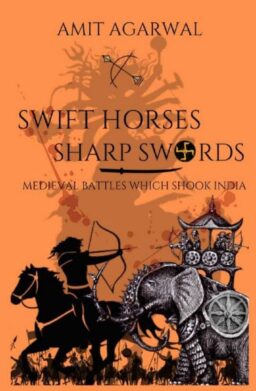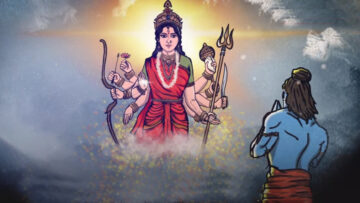A new well-researched book on Indian medieval history titled “Swift Horses Sharp swords: Medieval Battles which Shook India” is penned by Mr. Amit Agarwal, an engineer from IIT- Roorkee. Currently, he is working as a General Manager in a prestigious Maharatna oil PSU and is an avid marathoner & mountaineer as well. This is his first book on a subject he is passionate about.
As the author mentioned in the preface that most of the history books he has come across were written in a left-liberal narrative which more often than not, failed to depict the true picture of Indian history. Hence, he was driven to author such a book that aptly described events from a Hindu perspective in an engrossing manner.
Indian history has so far been intentionally depicted with its fulcrum on the Arabs, Turks and Mughals in the medieval period. Incidentally, this has become a very controversial topic of late as the people are demanding for the modification in NCERT history books to correct the glorification of the invaders. It was always portrayed as if invasion was a cakewalk for them but the book brings out the fact in no uncertain terms that warriors of that time were not easy prey.
It delineates the historical time zone from the 7th century till the 13th century and analyzed the conditions encompassing all the social, economic, religious, technological, and geographical factors of that era and their interplay. The book has the microscopic analysis of history without overlooking the larger world view. Consequently, we now have an amazing historical compilation of intense bravery though hardly remembered and frugally told before.
The book presents a comprehensive integration of history with engineering, mathematical, and management fundamentals. It relates the historical events with contemporary knowledge of game theory, chaos, scatter/randomness, network theory, bell & sinusoidal curves and Maslow pyramids etc. and their correlation and causation is a key takeaway for this unique version of history. The book also has an unusual chapter that clearly describes that homogeneous societies excel on the most parameters.
The inverse relationship between ethnic diversity and economic and social progress is clearly established in the book. Hence, all the advanced and rich countries like Japan, China, European nations and the USA to some extent are homogenous, while the heterogeneous countries including India remain slacker. This theory has suitably been strengthened with the authentic tabulated data. It has also tried to prove why our progress has been lukewarm even after independence and at the same time, why our religion and culture is still intact despite such horrific onslaught over the centuries.
The book has three distinct parts. First part deals with ancient India and its glory. It also has chapters on the rise of Hinduism and Buddhism and how India had tremendous influence over the Silk Road and South-East Asia.
A chapter was devoted to the history of Swastika and Aryan migration theory. He could have elaborated more on Aryan theories as they are such controversial topics nowadays. Maybe this book is about the medieval era, so the author might not have wanted to devote much space on this issue.
Second part deals with Islamic invaders and why Indian kings and warriors were defeated despite their bravery. These factors and underlying conditions are examined in detail.
Third part primarily deals with the overall analysis and interesting anecdotes. One chapter delineates the penchant of Islamic invaders to create pyramids of the human heads with horrific details.
Further, how polytheistic societies recognize other gods without any malaise and why the concept of Karma is built in every such society is thoroughly explored. It also tries to find out why all polytheistic communities are paragons of tolerance.
The book is also full of such heroes who fought bravely against them but lack of technological prowess had done them in. It correctly brings out this aspect of technology by which sturdy Chainmail armour, solid tree saddle and the metallic stirrup were designed and developed in Central Asia. Due to this Turks could accurately fire 6 arrows per minute while galloping on the horse.
Few other facts are also eye-opening like Turks could travel 100 kilometres per day which meant they could come to Delhi in a flat 10 days from Ghazni in Afghanistan.
The book has also brought out the follies committed by the Indian warriors in that period. Despite being super rich, somehow innovation in military strategy, technology, and tactics could not keep pace with that of the Turks.
The overemphasis of Dharamyuddha was another huge factor in the recurring defeats. Just to quote an example: Ghori was lying on the battlefield unconscious with injuries and Rajputs had all the time to kill him.
Yet they did not find it morally right to kill an injured and unarmed warrior. Consequently, His soldiers managed to take him back to Ghazni. He then practiced with the dummy mud elephants as the Indian elephants were his chief nemesis in the battle. Within a year, Ghori came back to rule over India for centuries.
The key takeaway of the book is to make the current Indian generation proud of their brave ancestors who lost primarily because of their lack of unity and other myriad reasons and certainly not due to any cowardice which resulted in the Turkish conquest of India.
There were numerous instances when invaders were defeated squarely, however, these warriors are largely missing from the NCERT textbooks who only tried to portray Hindus as a bunch of losers.
The book correctly bemoans the fact that many of the cities and stations in India are named after the brutal invaders. To quote an example from the book: Railway station of Nalanda is named Bakhtiyarpur after Bakhtiyar Khilji, who burnt the university and left it in ruins. Any attempt to change such names usually results in vociferous protests by secular Hindus first. The current opposition to rename Aurangabad in Maharashtra can be seen as an appropriate example of this malaise.
Author has given a few references of the battles in Europe and elaborated that with little ingenuity Europeans were able to defeat Arabs squarely. There is also a mention of Greco-Persian war in 5th century BCE where Spartans were able to check the Persian invasion for days with only 300 soldiers. Author wished that our warriors too were able to check the invaders at narrow Khyber Pass.
The book is a study, written in simple English fathomable to all Indians. It is crisp, concise, fast-paced and targeted towards those who know little about this dreadful chapter of Indian history but want to know the complete history in a nutshell. It is also littered throughout with the interesting historical anecdotes which makes it a light read.
However, the book is a little long read consisting of more than 500 pages, which could have been easily split into two volumes and hence, would have made it more enjoyable. Better print quality could have certainly made it more attractive. There were some repetitions in the book which could have been avoided with a little more tight editing.
Finally, the book has the potential to make the Hindus proud of their roots, traditions and culture and if it could convert few seculars into Sanatani, it would be a huge success for the book!
Swift Horses Sharp Swords is available on Amazon.
Disclaimer: The opinions expressed in this article belong to the author. Indic Today is neither responsible nor liable for the accuracy, completeness, suitability, or validity of any information in the article.







